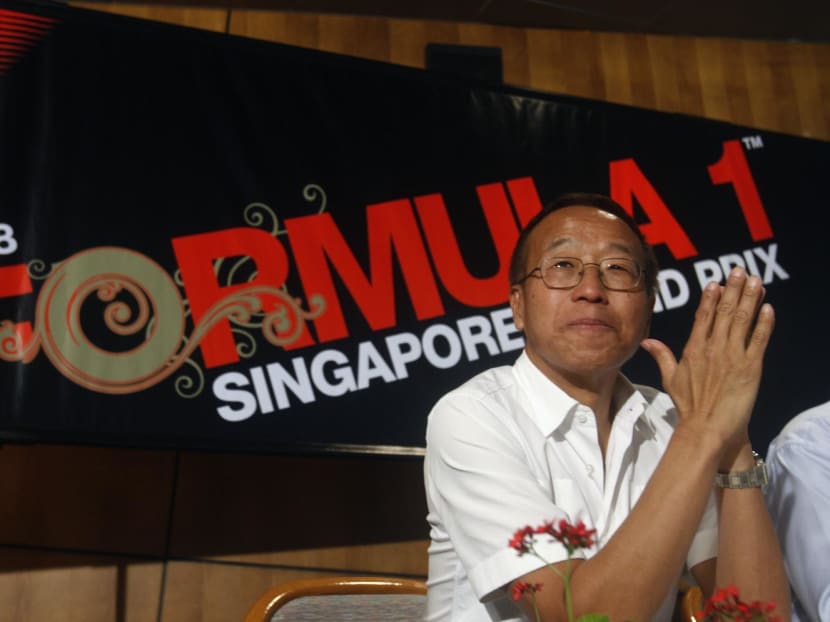Explainer: Why is Ong Beng Seng allowed to go overseas amid CPIB probe and how is bail usually set?
SINGAPORE — When news broke that businessman Ong Beng Seng had left Singapore after he was placed under arrest to assist the Corrupt Practices Investigation Bureau (CPIB) in investigations, questions soon arose as to why he was allowed to travel.

Mr Ong Beng Seng at a news conference in Singapore in May 2007.
- Questions arose as to why businessman Ong Beng Seng was allowed to leave Singapore after his arrest by the Corrupt Practices Investigation Bureau
- Some members of the public also queried the bail quantum of SS$100,000, a seemingly small amount for a billionaire
- Legal experts told TODAY that the amount and conditions of bail set for an individual are determined by a host of considerations beyond financial, including one’s flight risk
- Given the lack of details on the case, the experts explained the possible offences covered under the Prevention of Corruption Act and where the line is drawn between a gift and a bribe
SINGAPORE — When news broke that businessman Ong Beng Seng had left Singapore after he was placed under arrest to assist the Corrupt Practices Investigation Bureau (CPIB) in investigations, questions soon arose as to why he was allowed to travel.
Some members of the public also asked about the amount of bail posted: S$100,000, a seemingly low sum for a billionaire such as Mr Ong.
This came after luxury hotels company Hotel Properties Limited (HPL), a listed firm of which Mr Ong is the managing director and founder, announced on Friday in a Singapore Exchange filing that he has been arrested and is assisting the CPIB with its probe into a case linked to Transport Minister S Iswaran.
Mr Ong will be travelling from Friday, the company added.
In response to queries by TODAY, CPIB said on Friday night that both Mr Ong and Mr Iswaran were arrested on Tuesday and were subsequently released on bail.
"As part of bail conditions, subjects’ passports are impounded. Subjects on bail can however make requests to travel overseas," said the bureau.
It added that it assessed and acceded to Mr Ong’s request to travel overseas and increased his bail quantum to S$100,000.
"Upon his return, Ong is required to report to CPIB and surrender his passport to the bureau," said CPIB, which did not say what Mr Ong's original bail amount was.
TODAY spoke to lawyers and legal experts on how enforcement authorities determine whether a person will be granted permission to travel while under investigation and the bail amount to be granted.
As little has been revealed about the case under probe, TODAY also asked legal experts what are the potential alleged offences being probed and what can constitute corruption under the law.
NOT UNUSUAL FOR THOSE UNDER PROBE TO TRAVEL OUT OF SINGAPORE
The experts said that it is not unheard of for a person assisting with investigations to apply for permission to leave Singapore after posting bail.
“It is certainly not out of the ordinary — for all sorts of alleged offences, not just corruption,” said Mr Benjamin Joshua Ong, an assistant professor of law at the Singapore Management University (SMU).
The relevant authority would then review whether the individual poses a flight risk or otherwise.
Ms Diana Ngiam, a criminal lawyer and director at firm law Quahe Woo & Palmer LLC, said: “This inquiry will typically involve a determination of factors including the suspect’s risk of absconding, the severity of the allegations and the purpose of travelling.”
Assistant Professor Ong said that whether the person applying to leave can show a clear travel itinerary or if the individual “has ties to Singapore that would incentivise the person to come back” are also taken into consideration.
HPL’s Mr Ong is a Singapore permanent resident from Malaysia with business interests in the hotel, entertainment and lifestyle industries.
In May last year, HPL also led a consortium to buy the real estate assets of media company Singapore Press Holdings.
Asst Prof Ong said: “If the person wants to leave Singapore, it is possible that the bail amount will be increased or the number of sureties will be increased, or both.”
HOW LOW IS TOO LOW FOR BAIL?
According to Forbes magazine, Mr Ong and his wife had a combined net worth of US$1.75 billion (S$2.31 billion) last year. Naturally, questions arose online as to why the bail was set at S$100,000, a relatively low amount compared to Mr Ong's wealth.
A partner at law firm Eugene Thuraisingam LLP, Mr Chooi Jing Yen, said that in general, many factors are taken into consideration in the setting of the bail amount.
These include but are not limited to the amount under investigation and the financial means of the individual.
“For example, if he's a very wealthy individual (and) you give him a low bail amount, it is not going to be much of a deterrent to secure his attendance,” said Mr Chooi.
He pointed to examples of Hin Leong founder and former oil tycoon Lim Oon Kuin, who went on trial in April for charges of cheating a bank and instigating forgery involving S$148.7 million, and was out on bail of S$4 million.
Ng Yu Zhi, the founder of Envy Global Trading who is at the centre of an alleged billion-dollar nickel investment fraud case, was remanded in February as he was unable to raise bail of S$6 million.
Mr Chooi made clear that these were not corruption cases but merely examples “just to illustrate how bail is considered”.
To date, no detail has been revealed on the alleged amount being probed by CPIB in the case involving Mr Iswaran and Mr Ong.
Meanwhile, Ms Ngiam said that while the bail amount may appear low “at first glance” for someone of Mr Ong’s financial standing, “financial status is one of many factors that the authorities consider when deciding on the bail quantum”.
Mr Marshall Lim, a partner at law firm Martin & Partners LLP, noted that HPL’s statement said that Mr Ong has posted "bail", which implies a third party has come forward to post bail on his behalf.
In setting the bail amount, the means or net worth of the bailed individual “should not take centre-stage, tempting as it might be”.
“The focus should be on the bailor, and whether the quantum of bail would be effective in ensuring the bailor’s performance of his or duties,” he said.
HPL and CPIB did not state who posted bail for Mr Ong.
WHAT ARE THE POSSIBLE OFFENCES CPIB IS PROBING?
Given the little detail available, it would be “speculative” at this point to determine the specific corruption offences being probed, said law professor Eugene Tan from SMU.
“As CPIB is leading the investigation, the entire Prevention of Corruption Act (PCA) applies,” said Associate Professor Tan.
The PCA covers various offences relating to bribery including corruptly soliciting, receiving, giving or offering any gratification as an inducement to or reward a certain action.
A corruption offence can attract a fine of up to S$100,000 or a jail term not longer than five years, or both.
Under Section 11 and 12 of Part Three of the Act, the jail term can be enhanced to up to seven years if the bribe involves a Member of Parliament or a member of a public body.
“More importantly, when someone who wants to deal with the Government or a public body gives or receives a ‘gratification’ (that is something of value) to an employee of the Government or a public body, it is presumed that there was corrupt intent, unless the accused person proves otherwise,” said Asst Prof Ong, referring to Section 8 of the Act.
Assoc Prof Tan added that if other criminal wrongdoing is uncovered, CPIB may refer the persons under probe to the relevant law enforcement agency.
For example, white-collar crimes may be referred to the police's Commercial Affairs Department.
WHEN IS A GIFT NOT A GIFT?
The legal experts said that the definition of corruption is wide, with no minimal dollar-value threshold. In fact, the gratification involved may not necessarily be limited to monetary form.
Mr Chooi said that some cases of corruption can be straightforward, where for example one party corruptly offers gratification to induce a favour such as to be awarded a particular contract or gain advantage in the contract-awarding process.
But it could also be deemed by the court as a form of corruption if one were to go out very frequently with another party even without discussing any specific contract.
"In the course of doing that, you're basically cultivating a relationship so that every time you tender for the job, they (the other party) will view your bid more favourably," he added, noting such was the case in the Ang Mo Kio Town Council graft case a few years ago.
"There was no specific link between each of the karaoke sessions and the contract awarded to the contractor but according to the court it's still corruption."
The experts acknowledged that exchanges of gifts or tokens may be commonplace in business settings.
"Context matters immensely as to whether a gift is indeed a gift or intended as a bribe," said Assoc Prof Tan.
"A bribe can be of any monetary value and a bribe need not be money; what matters is what the bribe receiver desires and regards as sufficient inducement."
To mitigate risks of corruption arising, measures such as making declarations when giving or receiving them may help.
"While these steps will not completely immunise an organisation and its staff from corrupt activities, it will create hurdles that will hopefully deter people from engaging in corrupt activities," said Mr Lim.











